What should be paid attention to in the early selection of air classifier
The jet classifier is the key equipment for the jet mill to control the particle size of the powder. It also has a strong application effect and has a very high utilization rate in all walks of life. Many customers do not know what standard to choose according to the air classifier before purchasing, and do not know whether the air classifier equipment has excellent performance according to which performance, which caused some doubts in the early stage of selection, and may also buy an inappropriate The airflow classifier. What should we pay attention to in the initial stage of air classifier selection.

1. In the initial stage, you should understand and analyze the type, working principle, and performance characteristics of the selected equipment. Only by fully understanding the equipment can the selected equipment fully meet the production requirements.
2. After the selected equipment is put into production, it is necessary to know which parts are easy to wear, what is the replacement cycle of wearing parts, and whether the equipment needs auxiliary equipment during operation and what equipment is needed. Properly controlling these will save time and financial resources for future production.
3. Go to the production plant to inspect the equipment you want to buy. Because the equipment cost accounts for a large part when the factory is built, and the equipment is very complicated from design to finished product, the equipment manufacturer cannot fully introduce it. The equipment technical indicators given are only for reference when equipment selection, and cannot fully represent the equipment parameters.
4. When purchasing the main equipment of the classifier, relevant auxiliary equipment should be purchased as much as possible to complete the installation at one time, save time and proceed smoothly. Because the auxiliary equipment related to the host recommended by the equipment manufacturer has been practiced.
Application of silica in the fields of rubber, plastics and coatings
Silica is widely found in nature, and it is the main component of ceramics, glass and other non-metallic products. In particular, ultrafine silica has a large specific surface area, strong surface adsorption force, large surface energy, high chemical purity, good dispersion performance, thermal resistance, electrical resistance, etc. due to its small particle size. With its superior stability, reinforcement, thickening and thixotropy, it is widely used in rubber, plastics, coatings and other fields.
Rubber
- Application in vulcanized silicone rubber
The most widely used in rubber is fumed silica, which is mainly used as a reinforcement in vulcanized silicone rubber. Because the molecular chain of silicone rubber is very flexible and the molecular interaction between the chains is very weak, the strength of the unreinforced rubber is very weak and has no use value. It must be reinforced before it can be used.
- Application in medical rubber
The rubber with fumed silica as a reinforcing agent has good physical properties and has a wide range of applications in medical treatment. Its products involve various departments of medicine, such as craniocerebral surgery, ENT, anesthesiology, digestive system, cardiac surgery, and abdominal surgery. Surgery, urinary and reproductive system, etc. At the same time, sterile rubber medical gloves and disposable rubber examination gloves, medical hoses and medical silicone rubber catheters, medical bottle stoppers and artificial silicone rubber organs are also medical rubber products. As a medical rubber product, it must meet the requirements of non-toxic, chemically inert, non-allergenic, non-pathogenic, non-deformable, easy to process, and good anti-aging properties. Silicone rubber can basically meet these requirements.
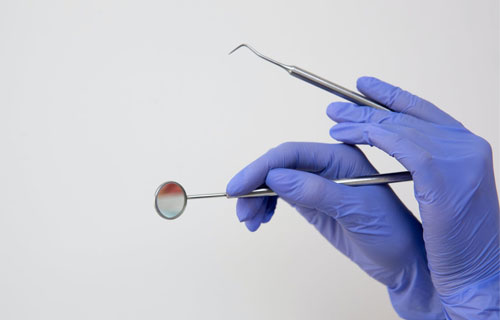
- Application in tire rubber
Compared with carbon black, nano-silica filled green tires have low rolling resistance and low fuel consumption, so they can replace the trend of carbon black filled car and truck tires. Now the concept of green tires has emerged. Green tires not only refer to fuel-efficient, safe, and low rolling resistance tires, but also meet the greening of raw materials and production processes.
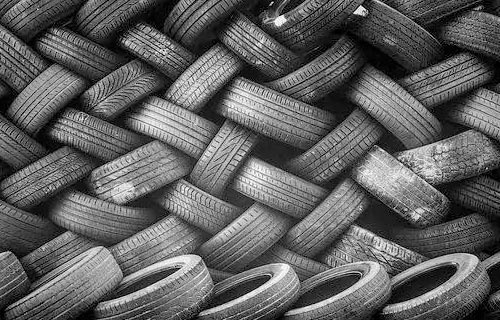
- Application in daily necessities
Nano-silica has good reinforcing properties and can improve the physical and mechanical properties of rubber. It is widely used in household appliances and rubber products in cultural and sports education.
- Role in hose tape and rubber shoes
Hose tape is two important parts in the rubber industry. In its production process, it is necessary to improve its wear resistance and fatigue resistance, so white carbon black needs to be added to meet the requirements of use.
In rubber shoes, especially in shoe soles, white carbon black can replace carbon black 100%, so rubber shoes are one of the industries that consumes more white carbon black. As a reinforcing filler, white carbon can enhance the wear resistance, tensile strength, tear strength and hardness of the sole, so it is widely used in the production of light-colored, colored translucent and transparent soles.
Plastic
- Application in thermoplastics
The traditional method of toughening plastics is to add rubber-like substances to the matrix. Although this method greatly improves the toughness of the material, it also greatly reduces the strength and processing performance of the material.
The toughening principle of fumed silica toughened plastics is the toughening of inorganic rigid particles. After it is added to the plastic, it can improve the toughness of the material without weakening the rigidity of the material, and even increase the rigidity of the material.
- Application in thermosetting plastics
Adding fumed silica to epoxy resin can significantly improve its brittleness, overcome the defects of material rigidity and strength reduction caused by the toughening of elastomers, and achieve the purpose of strengthening and toughening.
- As a flame retardant additive
Because fumed silica increases the strength of the carbon-silicon layer through the physical process in the condensed phase, it can prevent the transfer of heat and substances during combustion. By adding fumed silica to the EVA/MH blend and reducing the total filling amount, the elongation at break can be doubled when the flame retardant properties remain unchanged.
Coating
- Application in light-curing coatings
Ultraviolet curing coating (UVCC) is an environmentally friendly and energy-saving coating developed in the 1960s. Compared with traditional coatings, it has the characteristics of economy, environment friendliness, energy saving and high efficiency. Its disadvantages are that the equipment and raw materials are more expensive, the adhesion is poor, and it is easy to crack.
Filling the nano-silica into the ultraviolet curable coating can significantly increase the hardness of the coating after curing, and also improve the heat resistance. At the same time, it can improve the curing speed, hardness, adhesion and thermal stability of the UV-curable coating film at low temperature.
Studies have also shown that the presence of nano-silica can significantly improve the wear resistance, hardness, impact strength and flexibility of epoxy acrylate UV curable coatings.
- Application in architectural coatings
Nano-silica can effectively reduce the color difference of the coating caused by ultraviolet and infrared light irradiation, and improve the aging resistance of exterior wall coatings. It can also significantly enhance the hardness, adhesion and weather resistance of the coating, increase the viscosity and anti-settling ability of the coating, and enhance the stability of the coating.

- Application in color inkjet printing paper coating
Color inkjet printing paper can often be used in daily life, especially many large companies often use it for document printing. However, due to the micropores and cracks on the surface, it is necessary to have a primer to improve the performance of this paper. And if nano-silica is added to the primer, it can not only effectively improve the effect of the primer, but also improve the overall quality of the paper, and provide good absorption performance for the paper.
Moreover, if nano-silica is added to the pigment, a special coating for digital color inkjet printing paper with good performance can be made, which not only can make the coating load moderate, but also can effectively solve the problem of formaldehyde, the printing effect is good, and the material is easy. Yes, it can be said to be economical and useable.
- Application in plastic coatings
Nano-silica can also have a good promoting effect on the related thermal properties of polyethylene, not only can effectively improve the thermal stability of the composite material, but also the flame retardant performance will be greatly improved. It can be said that in the application of plastic coatings, nano-silica can fully improve the overall quality of the coating.
- Application in metal protective coatings
The use of silica is very extensive in the field of coatings, especially if nano silica is added to metal protective coatings, the quality of the coatings will also be further improved. Many researchers have tried nano-silica, and the results show that nano-silica can significantly enhance the strength of the carbon layer of metal protective coatings, and it will also increase the fire resistance of steel building materials.
Article source: China Powder Network
The safety of the inert gas protection jet mill is a major feature
The inert gas shielded jet mill is used in metal powder, easily oxidized raw materials, flammable and explosive raw materials, pharmaceutical ultrafine powder and other industries and raw materials that require inert gas protection. Typical materials are: cobalt powder, tungsten powder, iron powder, nickel powder, tantalum powder, selenium powder, fine spherical aluminum powder, neodymium iron boron, carbonyl iron powder, selenium powder, etc. The inert gas shielded airflow pulverizer is based on the fluidized bed airflow pulverization classifier, and uses nitrogen or carbon dioxide as the pulverizing working medium. It consists of nitrogen compression system, nitrogen filtration system, crushing system, classification system, collection system, feeding and unloading system, nitrogen purity test supplement system, nitrogen generation system and electrical control system.
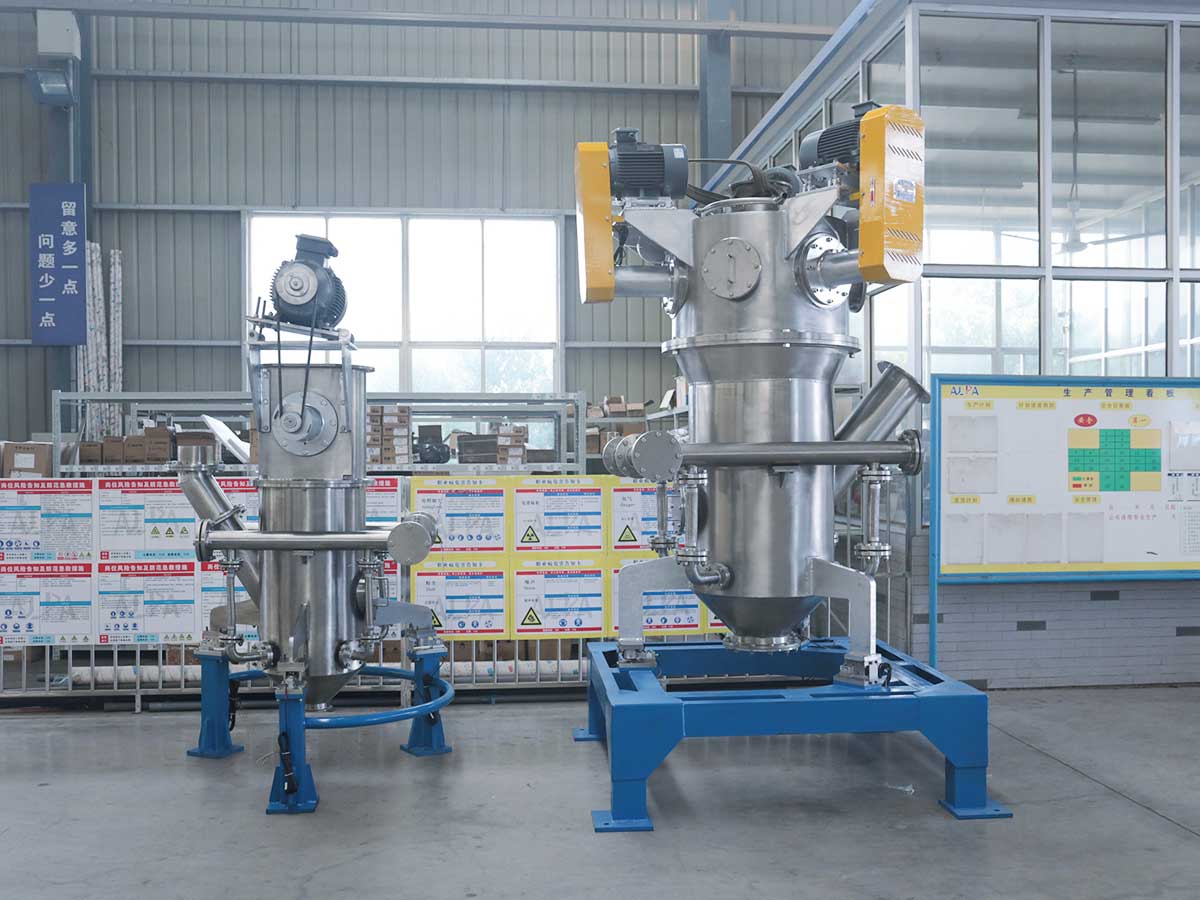
The entire production line of the inert gas protection jet mill equipment adopts fully enclosed negative pressure operation, and there will never be dust and dust pollution on the production site. Using PLC programming control, safety measures are multi-pronged and work in parallel, and only one of the measures is effective to prevent potential safety hazards. In terms of safety, the nitrogen-protected crushing equipment has the following characteristics:
- Isolate oxygen. During the process, an oxygen content tester is used to continuously monitor the oxygen content in the airflow, and when it exceeds a certain level, it will immediately add nitrogen to keep the oxygen content within the safety production standard.
- Control the concentration of gas and powder: the feeding system of the equipment is a fully enclosed, uniform speed device, which is programmed and controlled by the control cabinet. Fully enclosed plays the role of isolating oxygen, and the uniform speed controls the concentration of the material inside the added equipment, and the feeding speed can be set arbitrarily.
- Discharge static electricity in time and eliminate ignition sources: The special filter material with carbon steel wire used for the pulse blowback collector can eliminate static electricity in time and ensure that the pulse dust is clean and thorough. The equipment is all metal components, all grounded, in order to release the powder static electricity as much as possible.
- Circulating cooling: explosion-proof and dust-proof, emergency shutdown.
The above is the introduction of the safety advantages of the inert gas shielded jet mill. It is precisely because of these performance characteristics that the inert gas shielded jet mill has been applied in more industries, bringing new opportunities for the powder processing industry.
What are the development directions of supersonic jet mills?
At present, the development trend of powder granulation technology is toward the direction of large-scale equipment, compact structure, high-tech processing technology, diversified functions, high efficiency, and automation of control systems.

- Large-scale equipment
With the advancement of science and technology and the development of technology, the advantages of large-scale production equipment have become more and more obvious. At the same time, the application of CAD/CAM technology and precise stress analysis technology has promoted the development of mechanical structure design and processing and manufacturing technology. The large-scale granulation equipment provides a solid technical guarantee. At present, the powder granulation equipment is developing in the direction of large-scale, and the single-machine processing capacity of the super-large screw extruder can reach 25-30t/h. Taking the screw granulator as an example, the maximum screw diameter of the existing equipment is 240mm, and the single machine processing capacity exceeds 2t/h. A super-large screw granulator with a screw diameter of 380mm and a single machine processing capacity of more than 4t/h is under development; a rotary cold belt drop molding device, the width of the condensed steel belt under development is more than 1.5m, the equipment length exceeds 20m, and the single machine processing capacity More than 6t/h.
- Compact structure
Another development trend of jet milling equipment is compact structure. The structural design of the equipment is more reasonable, more compact, and more ergonomic, thereby reducing manufacturing costs, reducing floor space and improving labor efficiency. Take the screw granulator as an example, the direct connection of the motor replaces the traditional belt drive, making the equipment more compact and the transmission torque is greater; the variable pitch design is adopted, and the material conveying section, kneading and extrusion section are designed on one shaft , So that the conveying, kneading, and granulation can be completed at one time. These design concepts all represent the development direction of powder granulation equipment.
- High-tech processing technology
With the expansion of the application field of powder granulation equipment, traditional mechanical processing methods can no longer meet the needs of powder design technology. In the future, the processing technology of powder equipment will develop in the direction of high technology. For example, computer-aided design/manufacturing (CAD/CAM) technology is used to design and process the screw thread profile, special deep hole processing equipment is used to process the slender hole of the cold belt die distributor, and the five-axis CNC bed is used to realize the space twisting blade Profile processing, using plasma cutting machine, laser, EDM to process small aperture templates, using nano technology (nanometer coating) to process extrusion screws and rotating steel belts to solve material holding rods, product demoulding, etc.
- Diversified functions
The powder post-processing project is a system project that includes many unit operations in multiple disciplines and categories. It is required that the selection of powder granulation equipment should reduce the intermediate steps to save investment; at the same time, the market demand for products also requires production Manufacturers can provide products in various forms. This requires diversification of the functions of powder granulation equipment. Take the special extruder pelletizer for catalyst as an example. Based on the ordinary single-screw pelletizer, this machine has been specially designed and improved. It consists of two parts, extrusion and pelletizing, which can complete the extrusion and pelletizing in one machine. At the same time, by replacing the die template, granular products of different particle sizes and shapes can be obtained; the rotary belt molding device can realize hemispherical, flake, block, and stripe shapes by replacing parts such as distributors and overflow weirs. The production of products with different shapes, such as the shape, greatly facilitates users and truly realizes the diversification of functions.
- Efficiency and efficiency
With the improvement of people's awareness of energy saving, higher requirements are put forward for the efficiency of powder granulation equipment. This type of equipment is required not only to meet functional requirements, but also to be energy-saving, durable, and low in use, maintenance, and repair costs to reduce product costs. Take the crushing granulator as an example. If a traditional electromagnetic speed-regulating motor is used and an ordinary speed regulator is used to regulate the speed, the motor power needs to be 45kW. If the frequency conversion speed motor is used and the frequency converter is used to adjust the speed, it can save energy by more than 30% in actual use; the dual-axis differential continuous kneader, due to the specially designed high-efficiency kneading element, has an operating time compared with ordinary screw kneaders. Cut it in half and more than double the efficiency. The adoption of these technologies indicates that high efficiency has become one of the main goals pursued in the design of powder granulation equipment.
- Control system automation
With the advancement of science and technology and the development of automatic control technology, whether to adopt assembly line operation and automatic control has become an important indicator to measure the advancement of powder post-processing technology. The control system adopts automatic control, which can not only ensure the flow of the production process and reduce the labor intensity of the operators, but more importantly, it can ensure the accuracy and real-time feedback of the production process, improve product quality, and reduce equipment failure rate. Taking the rotary belt molding device as an example, if the computer DCS distributed control system is adopted, not only can the automatic operation of feeding, granulating, conveying, packaging and other processes be realized, but also through various temperature, pressure, flow, speed and other sensors, real-time Monitor system status. When the system status and process parameters change, timely feedback the changes, send out an alarm signal, and adjust the parameters according to the preset status to automatically adjust the system status to ensure the normal operation of the equipment. It is foreseeable that the automation of the control system will greatly improve the technical level of the powder granulator equipment and become the inevitable direction of the development of powder granulation equipment.
What are the application fields and characteristics of the air classifier?
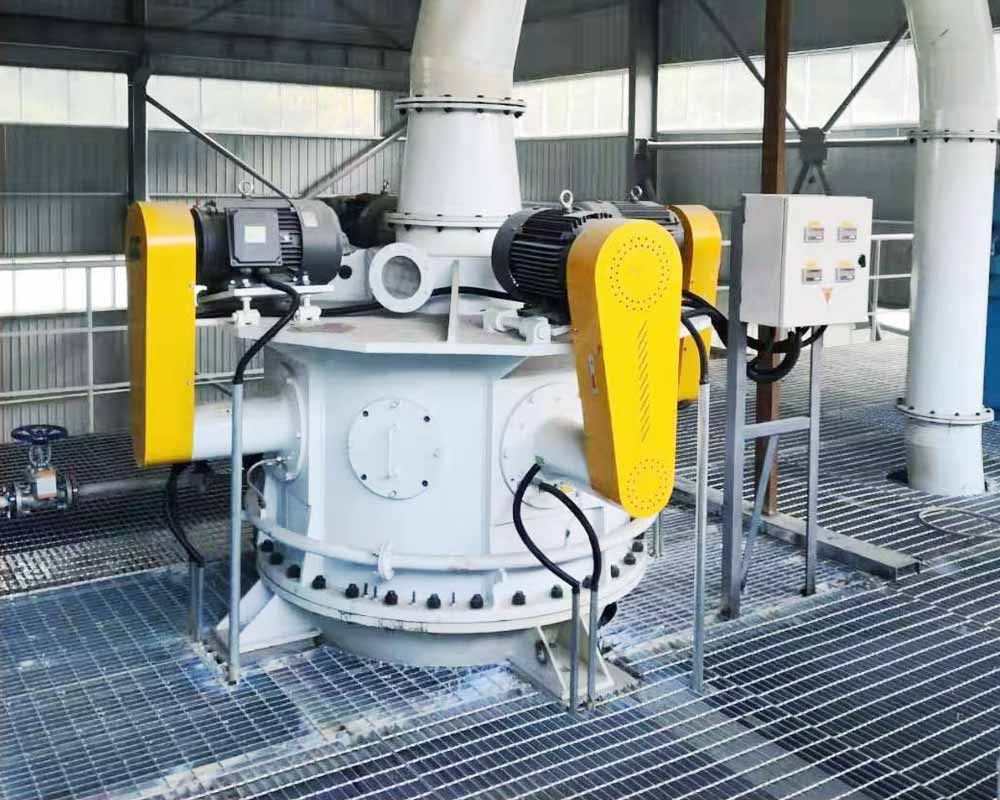
Application field of air classifier (material):
1. Superhard functional materials: silicon carbide, boron carbide, white corundum, brown corundum, diamond, zirconia, cerium oxide, high temperature alumina, silicon nitride, boron nitride, tourmaline, garnet, etc.
2. New chemical and polymer materials: magnesium hydroxide, aluminum hydroxide, aluminum oxide, carbon black, white carbon black, catalyst, titanium dioxide, activated carbon, ammonium polyphosphate, polyethylene wax, polyethylene, polypropylene, polyvinyl chloride , PTFE, epoxy resin, benzene aldehyde resin, fen aldehyde resin, paraffin wax, silica gel, titanium dioxide, dyes, flame retardants, blowing agents, zinc borate, etc.
3. Non-metallic minerals: calcite, dolomite, kaolin, talc, barite, quartz, graphite, coal powder, gangue, calcium carbonate (heavy, light), mica, vermiculite, pyrophyllite, spinel, Attapulgite, wollastonite, brucite, bentonite, limestone, diatomite, rectorite, sepiolite, petroleum coke, perlite, etc.
4. Metals and oxides: phosphorus iron, tantalum powder, selenium powder, spherical aluminum powder, molybdenum powder, high chromium iron, vanadium titanium, iron, aluminum, copper, zinc, tin, cobalt, nickel, magnesium, iron oxide, Alumina, zinc oxide, tin oxide, cobalt oxide, tungsten carbide, metallic silicon, stainless steel powder, alloy powder, etc.
5. New materials for batteries and copying: lithium cobalt oxide, cobalt oxide, lithium manganese oxide, manganese dioxide, lithium nickel cobalt oxide, lithium nickel manganese oxide, lithium carbonate, lithium iron phosphate, ternary materials, natural graphite, artificial graphite, Pitch coke, calcined petroleum coke, lithium hydroxide, cobalt tetroxide, ferrous oxalate, iron phosphate, carbon powder, etc.
6. Other materials: ceramic materials, refractory materials, electronic materials, magnetic materials, rare earth materials, phosphors, copy material powders, etc.
The performance characteristics of the air classifier:
1. It is suitable for the fine classification of dry micron products. It can classify spherical, flake, and needle-shaped particles, and can also classify particles of different densities.
2. The particle size of the graded products can reach D97: 8~150 microns, the product particle size is steplessly adjustable, and the variety is extremely convenient to change.
3. The classification efficiency (extraction rate) is 60% to 90%, and the classification efficiency of materials with good fluidity is high, otherwise the efficiency is reduced.
4. The vertical grading turbine device is adopted, with low speed, wear resistance, and low system power configuration.
5. Multi-stage classifiers can be used in series to produce products with multiple particle sizes at the same time.
6. It can be used in series with ball mill, vibration mill, Raymond mill and other grinding equipment to form a closed loop.
7. The control system adopts program control, the running status is displayed in real time, and the operation is simple.
8. The system runs under negative pressure, and the dust emission does not exceed 40mg/m³, and the equipment noise is not higher than 75dB(A) through the use of silencer measures.
Features of jet milling equipment
Air jet crushing equipment is used for various materials that cannot be crushed at room temperature. It is widely used in various chemicals, petrochemicals, machinery, ships, automotive industries, electronics industries, clothing, coatings, printing, engineering plastics, rubber, thermoplastic materials, hot melt Ultra-fine crushing of type materials, nylon, polyester, polyethylene, polypropylene, textiles, clothing, Chinese and Western medicinal materials, food industry and other products. The inert gas shielded airflow crushing system is a dry crushing system for flammable, explosive, and easily oxidizing materials. It consists of a nitrogen source, a compressor, a silo, a crushing host, a cyclone separator, and a dust collector. The material to be crushed enters the crushing area from the silo in a closed state, and the crushed material enters the classification area with the ascending airflow. The fine particles meeting the particle size requirements enter the cyclone separator and the dust collector to collect with the airflow, and the coarse particles return to the crushing area to continue. Shattered. The filtered inert gas is returned to the compressor suction port for recycling, meeting the requirements of environmental protection, energy saving, and clean production.
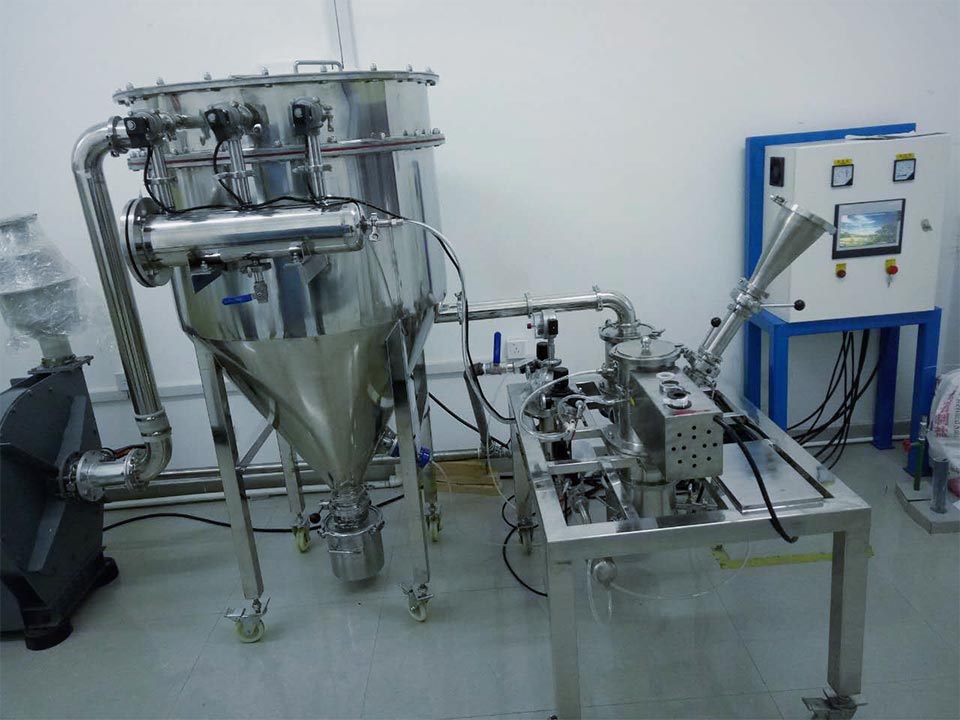
The working principle of the airflow crushing equipment: compressed air is filtered and dried, and then injected into the crushing chamber at a high speed through the Laval nozzle. The animal material is repeatedly collided and rubbed at the intersection of the high-pressure airflow and crushed. The crushed coarse and fine mixture plays a role in the negative pressure fan After reaching the classification area, the coarse and fine materials are separated under the strong centrifugal force generated by the high-speed rotating classification turbine. The materials that meet the particle size requirements are collected by the cyclone separator and dust collector through the classification wheel, and the coarse particles drop to the crushing area and continue to be crushed.
Features of jet milling equipment:
1. It is suitable for dry pulverization of various materials with Mohs hardness below 9, especially suitable for the pulverization of materials with high hardness, high purity and high added value.
2. The breakthrough of particle acceleration technology has greatly improved the crushing efficiency, reduced energy consumption, good particle shape, narrow particle size distribution and no large particles.
3. During the crushing process, the airflow temperature is reduced due to the rapid expansion of the airflow, which is especially suitable for the crushing of heat sensitive, low melting point, sugar-containing and volatile materials.
4. The crushing of materials by collision with each other is different from mechanical crushing which relies on the impact crushing of blades or hammers, etc., so the equipment is free from wear and the product is of high purity.
5. It can be used in series with a multi-stage classifier to produce products with multiple granularities at one time.
6. The equipment is compact in structure, easy to disassemble and clean, and the inner wall is smooth and has no dead corners.
7. The whole system is sealed and crushed, no dust, low noise, and the production process is clean and environmentally friendly.
8. The control system adopts program control, which is easy to operate.
9. Variable combined structure, compact structure, multi-purpose machine.
How to self-check and repair if the jet mill fails
The jet mill has a wide range of applications and high fineness of the finished product. Typical materials include super hard diamonds, silicon carbide, metal powder, etc. Ordinary air is replaced with inert gas, such as nitrogen and carbon dioxide gas, so that the machine can be protected by inert gas, which is suitable for crushing and grading treatment of inflammable, explosive, oxidizable and other substances.
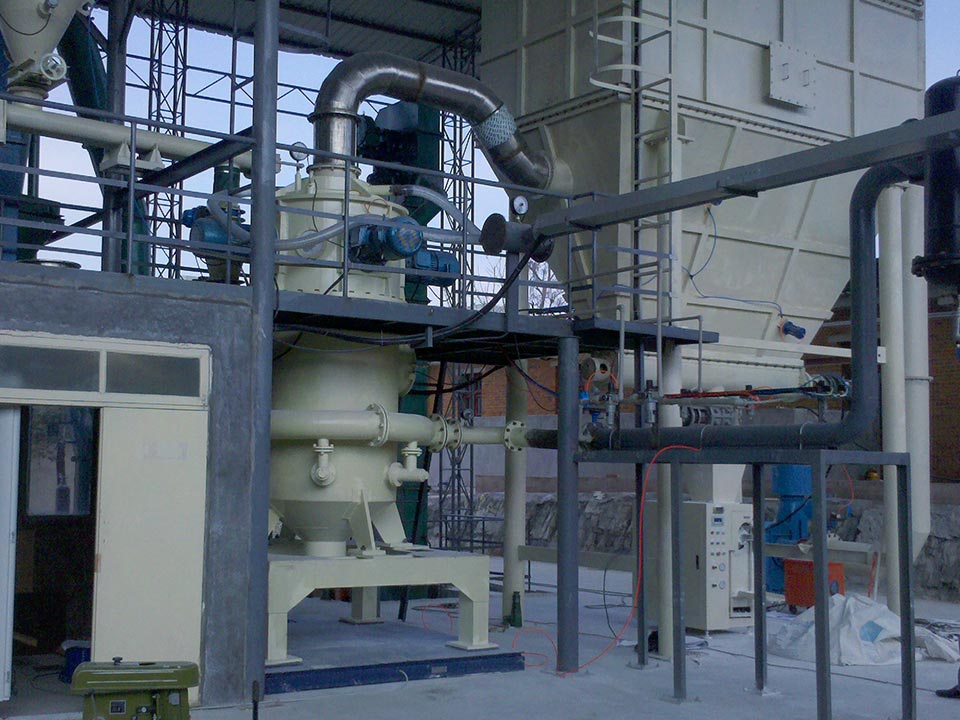
Too much, too little or aging lubricating oil in the bearings of jet mills is the main cause of bearing overheating and damage. Therefore, the lubricating oil is used according to the filling quantity. Generally, the lubricating oil uses 70% of the space, too much or too little. Conducive to bearing lubrication and heat transfer, extending the service life of the bearing. The matching bearing cap is tight with the shaft. Too tight or too loose matching between the bearing and the shaft will cause the bearing to overheat. However, by operating the shredder equipment in this way, the frictional noise and movement become more obvious, so the bearing should be disassembled, the friction part should be completed, and then reassembled as needed.
The pulverizer, cyclone separator, dust collector, and induced draft fan form a complete pulverization system. The dry compressed air is injected into the crushing chamber through a high-speed Laval nozzle. When the high-pressure air impacts the material, it repeatedly collides, rubs, shears, and crushes. The crushed material interacts with the upward air movement. The exhaust fan rotates at high speed, and the turbine is powerful. Under the action of the centrifugal force, the particles that meet the requirements enter the cyclone separator and dust collector through the classification wheel to collect, and the coarse particles return to the crushing zone to continue crushing.
The jet mill is a device that uses high-speed airflow to achieve ultra-fine grinding of dry materials. It consists of a pulverizing nozzle, grading and other components. The material enters the pulverizing chamber through a screw feeder, and the compressed air enters at a high speed through a special configuration of supersonic nozzles. In the crushing chamber, the material is repeatedly impacted, collided and crushed by the high-speed airflow.
Nowadays, jet mills are frequently used, and there are many types of popular mills on the market. Therefore, they have various problems. When encountering these problems, everyone always waits for maintenance personnel to inspect and repair, which is costly and troublesome. If we can perform self-examination and repair at this time, it will be much more convenient.
First, check the power socket, plug, and power cord for oxygen loss or breakage. If there is no such problem, you can plug in the power test machine. When the motor is energized and does not rotate, the wheel can be turned by lightly turning it by hand. It can be concluded that one of the two starting capacitors of the device has failed. If the discharge spark can be emitted and there is a loud "pop" sound, it means that the capacitor can be used; if the spark and noise are weak, it means that the capacity of the capacitor has decreased, and it needs to be replaced or added with a small capacitor. If the capacitor of the jet mill is damaged and short-circuited, this method cannot be used, and it must be replaced with a new product of the same specification to be repaired.
Regarding the safety issues when using the jet mill
The jet mill uses high-speed airflow to carry animal materials, so that the material particles collide and shear each other to achieve the purpose of ultra-fine pulverization. Because of its excellent pulverizing effect, it is favored by powder manufacturers in various industries. The typical materials of the jet mill are: super hard diamond, silicon carbide, metal powder, etc., high purity requirements: ceramic pigments, medicine, biochemical, etc., low temperature requirements: medicine, PVC. By changing the ordinary air in the air source to inert gases such as nitrogen and carbon dioxide, the machine can be used as an inert gas protection device, suitable for the crushing and classification of inflammable, explosive, and oxidizable materials.
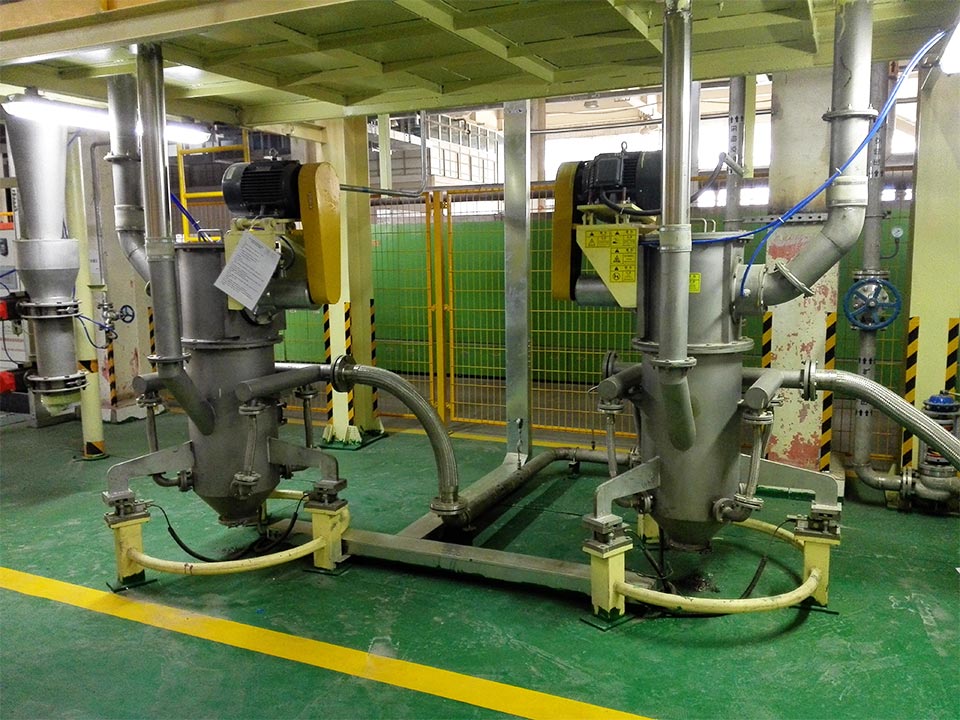
The safety issues of ultrafine powder processing with jet mills include respiratory pneumoconiosis and dust explosion. The particle size of the dust processed by the jet mill is basically below 5μm, and the dust below 5μm is the most harmful to the human body. Therefore, the probability of the operator of the jet mill operator suffering from pneumoconiosis occupational disease will increase significantly.
In addition, after the dust is scattered in the air on a large scale to form a dust cloud, a dust explosion may occur. Because the dust particles that are not captured during the processing of the jet mill have a suitable particle size and distribution state: generally the particle size is less than 5μm, the dispersion stability in the air is good, and it is easy to reach the explosion limit. If there is enough combustion-supporting air around these particles and has its minimum ignition energy, then dust explosions are prone to occur. Moreover, the shock wave generated by the explosion of a local dust cloud causes a large amount of deposited dust to fly up and mix with the air, which may form a secondary explosion. Because dust explosion has the characteristics of large energy, serious damage, short burst time, etc., it is easy to cause incomplete combustion, thereby producing a large amount of carbon monoxide gas to poison people. Therefore, the consequences of dust explosions are extremely serious.
What points should be paid attention to in the daily maintenance of the jet mill?
1. During the production process, the bearing temperature rise of the jet mill must be checked frequently. When the temperature rise exceeds 50°C, the machine should be shut down for inspection to find out the cause and eliminate the fault.
2. When the jet mill is running, the transmission belt is easy to stretch, so attention should be paid to adjusting the belt's proper tightness to ensure the working life of the belt.
3. The wearing parts should be checked frequently and replaced in time to ensure production quality and throughput.
4. The blades and bushings should be frequently checked for wear. After wear, the productivity will decrease and the particle size will become coarser. Replace it in time when it is found to be worn.
5. The main engine and graded flow bearings are all grease lubricated.
6. The grease replacement period for the bearings of the jet mill is 2000 hours, and the filling amount of the grease is 1/2 (upper measurement) or 3/4 (lower measurement) of the space in the bearing cavity. Do not fill with grease too much. Otherwise, the bearing temperature will be too high.
7. The grease change period of the screw feeder is 4000 hours, and ordinary calcium-based grease is added.
In fact, every kind of mechanical equipment has a certain degree of danger when in use, and the fluidized bed jet mill is the same. This requires us to master its use method, standard operation and scientific maintenance can minimize the risk of danger.
The jet mill can ensure the collection rate and yield of ceramic pigments
Ceramic colors refer to powdered metal oxides and other mixtures used for ceramic glazes, which are used to decorate ceramics, porcelain and terracotta, and are also used in porcelain enamels for decorative metalware. When it is in powder form, most of the ceramic pigments are off-white; although the particle size requirements of the pigments are not explicitly specified, it is generally required to pass a 300-mesh sieve. Insufficient pulverization will make it difficult to use due to uneven particle size, and lack of hiding power, resulting in spots after firing. On the contrary, if the crush is too fine as dust, it will not be fully fused in the glaze and become the cause of glaze rolling. Compared with other crushing equipment, the product morphology, particle size distribution, purity and other aspects obtained by the jet mill have obvious advantages.
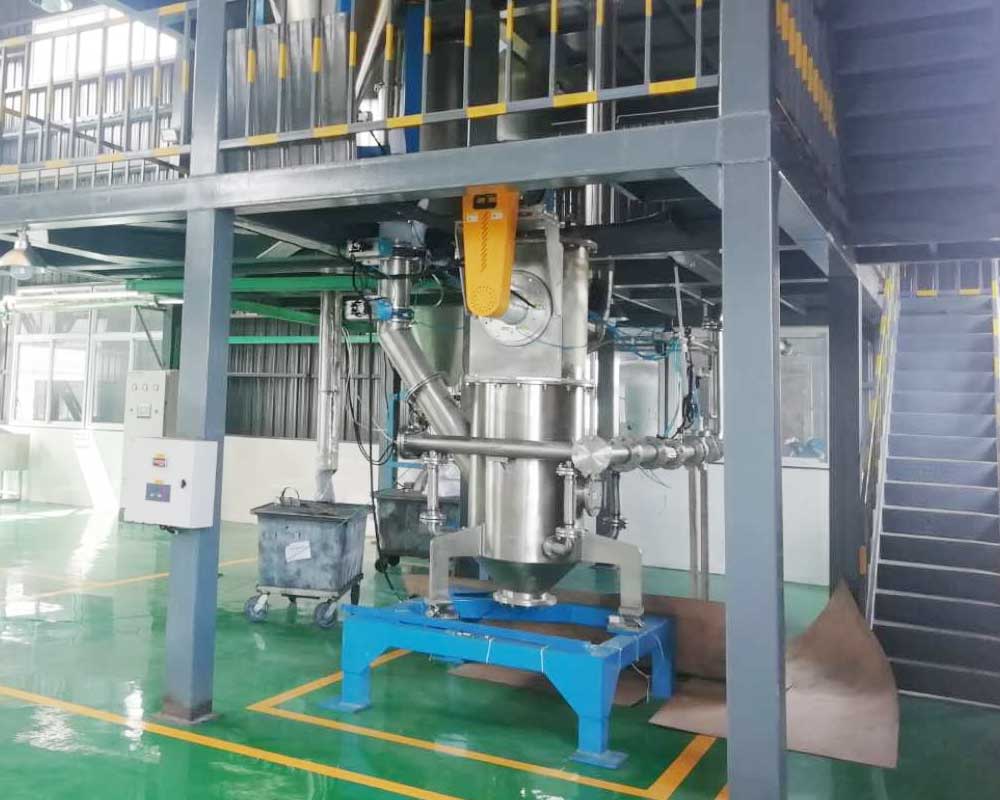
The ceramic pigment jet milling equipment strictly controls the distribution of particles to ensure a qualified collection rate and yield rate. The complete production line is our company's mature technology, with stable equipment performance, constant operating parameters and reliable quality.
Equipment characteristics of ceramic pigment jet mill
1. Avoid impurities doping into the materials to ensure the purity of the materials.
- Without water, washing, and completely dry production, one-time production can obtain fine powder materials with better particle size distribution and pollution-free, and the single-number finished product rate can reach more than 75%.
- Complete, stable and uniform flow field control technology; constant gas-solid concentration ratio design technology in the crushing cavity to ensure the stable and long-term operation of the system.
- Reasonable flow field design and special wear-resistant treatment for easy-wear parts greatly reduce the wear of the equipment, extend the service life, high classification accuracy, more accurate cutting particle size, lower speed required, and long service life.
2. In a fully fluidized state, an excellent spherical particle shape can be obtained; qualified micropowders are immediately classified to avoid excessive crushing. The company's unique frequency conversion feeding system helps to disperse materials, ensure continuous, uniform and stable feeding, and help product particle size control.
3. The complete and stable flow field established by the high-efficiency and high-precision classifier can strictly limit the generation of large particles, and obtain an excellent particle size distribution and a high and narrow particle size range. In particular, the core competitive advantage of more thorough extraction and good stability of fine powder has been widely recognized by the industry.
4. Once the operating parameters of the equipment are adjusted and fixed, the operation is stable, and there is no difference or change in the long-term continuous startup.
5. Fully enclosed negative pressure operation, low temperature crushing, high purity operation, no dust pollution, system emission <5mg/m3. The crushing chamber is equipped with an automatic slag discharge device, which can automatically remove the hard-to-grind particles and impurities in the material. It has the function of breaking up and dispersing agglomerated materials. Large flow of air means cooling and grinding, which can be used for processing heat-sensitive materials without deposition problems.
Ceramic pigment jet mill is suitable for typical materials: ceramic pigments (glaze, frit, etc.), ceramic raw materials (feldspar, porcelain clay, bauxite, etc.), ceramic raw materials (clay, gangue, etc.), special ceramics, diamonds , Green (black) silicon carbide, brown (white) corundum, cubic boron nitride, garnet, zircon sand, quartz sand, tungsten carbide, mullite, refractory materials, etc...
How to superfine lithium iron phosphate
Lithium iron phosphate battery is a new type of lithium ion battery that has attracted widespread attention in recent years. Because lithium iron phosphate ( LiFePO4 ) material has the characteristics of high specific energy, long cycle life, stable structure, good safety performance, and low cost, lithium iron phosphate Power batteries have many advantages such as high mass specific energy, low unit price, and high working potential. The pulverization of lithium iron phosphate is a very important link. The products processed by the principle of jet pulverization have narrow particle size distribution, no excessive pulverization and large particles, low fine powder rate, and high pass rate. They are the first choice of most battery material manufacturers. The lithium iron phosphate special jet mill has the characteristics of high yield, uniform particle size distribution, and good particle morphology. It can be widely used in micron-level experiments and production of battery powder cathode materials.
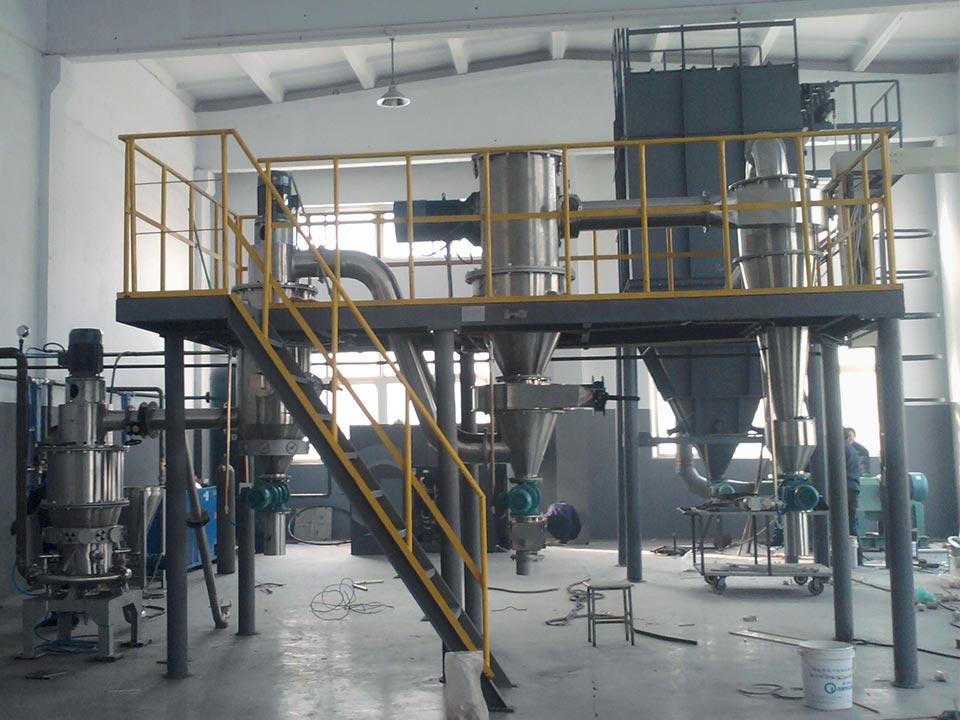
The special jet mill for lithium iron phosphate is a kind of equipment that uses high-speed airflow to achieve ultra-fine grinding of dry materials. It consists of a feeding zone, a crushing zone, and a classification zone. The material enters the crushing zone through the feeding zone, and the crushed material enters the classification zone with the upward air flow under the action of the negative pressure system. The fine particles that meet the particle size requirements enter the cyclone separator and the dust collector to collect with the air flow, but do not meet the particle size requirements The coarse particles return to the crushing zone to continue crushing.
The special jet mill for lithium iron phosphate also has the following performance advantages:
1. The jet mill has the ability of shaping, the finished particle has an excellent morphology, and can obtain spherical (potato-like) particles.
2. Narrow particle size distribution and high tap density of the finished product.
3. Mechanical ultra-fine pulverizer, low over pulverization, and the finished product rate can reach 75%-95% or more.
4. The inside of the equipment can be lined with wear-resistant materials, and the finished product has high purity and low equipment wear.
5. The air flow classifier adopts frequency conversion adjustment, which can be adjusted arbitrarily between 0.5μm and 100μm.
6. The equipment runs stably, and there is no difference or change when it is turned on continuously for a long time.
7. Fully enclosed negative pressure operation, automatic control, low noise and no dust pollution.
The structural characteristics of the special jet mill for lithium iron phosphate are:
1. The material contact cavity is lined with ceramic or coating to prevent iron pollution caused by the material crushing process and ensure the purity of the crushed items.
2. Does not heat up. The material is crushed under the state of gas expansion, and the temperature will not rise.
3. The wear is small, the particles collide and crush each other, and rarely collide with the wall surface. It is suitable for crushing materials with Mohs hardness below nine.
4. Low energy consumption, 15%~25% energy saving compared with other types of jet mills.
It adopts advanced automatic control, real-time display of running status, simple operation, and can form a central monitoring system with the equipment control system according to the actual requirements of customers to realize remote monitoring.
